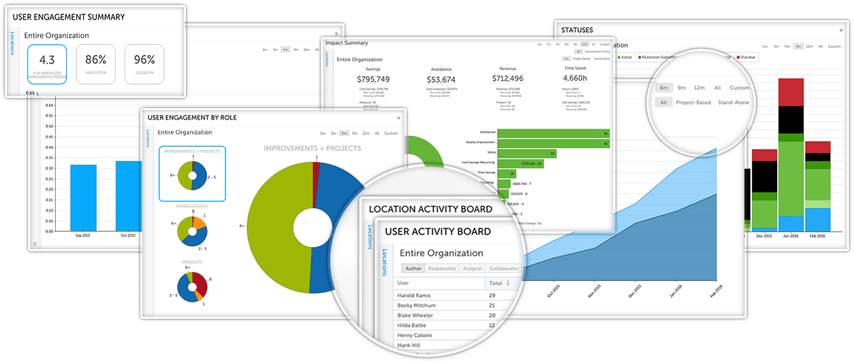 Organizations of all types across the globe have adopted the Lean management approach to business. Lean management got its start in automobile manufacturing in Japan, but today it is used by hospitals, software companies, retailers, and even construction firms. Improvement management software is not a requirement to practice Lean, but as with any process, structure and visualization can increase the odds of success.
Organizations of all types across the globe have adopted the Lean management approach to business. Lean management got its start in automobile manufacturing in Japan, but today it is used by hospitals, software companies, retailers, and even construction firms. Improvement management software is not a requirement to practice Lean, but as with any process, structure and visualization can increase the odds of success.
Our goal today is to lay out precisely what a Lean management system is and share some of the reasons that you might consider investing in one.
Essential Lean Management System Features
Improvement Collection
All positive change starts with the recognition that there is an opportunity for improvement. A fundamental function of Lean management technology is to provide a platform for capturing each idea for improvement. It should be easy for any person in the organization to enter a new opportunity. The solution should allow for as much detail and documentation to be attached as necessary. The best solutions are online, so they are available at any time from anywhere.
Virtual Huddle Boards
Many Lean organizations practice daily huddles in which the team gathers around a whiteboard or poster that reflects the current progress of improvement activities. Any Lean management system you consider should be able to replicate this visual management tool electronically.
Workflow with Notifications and Alerts
Lean management technology is designed to help ensure that forward progress on each project is maintained. Email alerts and notifications help make sure that nothing slips through the cracks and that employees stay engaged.
Impact Analytics
Every Lean organization should have measurable goals that they are working to achieve. A Lean system with impact analytics gives leaders insight into whether these goals are being met and it documents the impact of changes that are implemented, no matter how big or small.
Activity, and Engagement Reporting
It should be easy for leaders to gauge the health of the organization’s Lean culture using the improvement management platform. It should let them drill down into the activities and engagement of every department, team, and individual.

Top Benefits of Lean Software
Now that we’ve mapped out what a Lean management system should do, it’s time to get into why you should care. Here are the most important advantages you will get from this type of solution.
One View of the Truth
Your entire team will have one place to go for information on improvement activities that is always up to date and accessible. No more digging through emails or wondering if you have the latest version of the spreadsheet. Meeting are more efficient because everyone is looking at the most recent information about projects and assignments.
The Lean Culture is Reinforced
The Lean management platform helps to normalize the language and practices associated with Lean. Continuous improvement becomes a natural part of daily life in the organization. Employees see the fact that the company has invested in tools to support Lean as evidence that it is an important part of the long-term strategy.
Improvements Get Implemented Faster
We mentioned the importance of notifications and alerts as a feature of Lean technology. They are part of the reason that organizations with Lean software tend to get more improvements completed in less time than their counterparts who use spreadsheets or physical huddle boards. Managers are notified when a due date slips, so they can take immediate action to ensure that momentum isn’t stalled.
Knowledge is Retained
The Lean management system becomes a repository for the tribal knowledge of your teams. People can search through past improvement work to find best practices or hard lessons learned. Information isn’t lost when someone leaves the company or changes roles, and new employees can be quickly brought up to speed.
Collaboration is Streamlined
Cross-functional collaboration is central to the success of many Lean endeavors. Improvement management software makes it easier by providing a common platform for information exchange. Teams can work together on tough problems, and subject matter experts can be pulled in seamlessly when needed.
Success is Broadcast
Improvement work tends to be like a snowball that grows bigger as it rolls down the hill. One positive change inspires another. A Lean management system is ideal for broadcasting each successful improvement and recognizing those who made it happen. This is a powerful way to get employees excited and eager to tackle the next big challenge.
Implementing Lean technology does take careful consideration and planning. You’ve got to pick a feature-rich solution and roll it out in a thoughtful way. If you do, our customers will tell you that it pays off even more than you might expect.
For help choosing which Lean management system is best for your organization, download this free comparison matrix:
Improvement Software Comparison Matrix
Download this free matrix to:
- See a list of all features and functionality available in improvement platforms
- Calculate a weighted score for each platform based on available features and your organization's unique needs
- Make an educated, intentional choice about which improvement platform is the best fit for your organization



Add a Comment